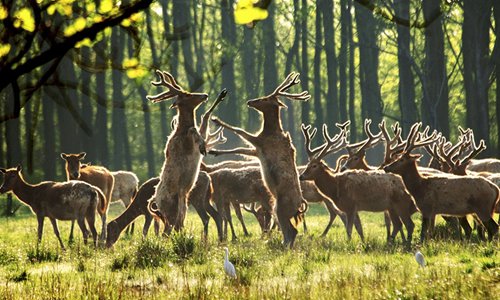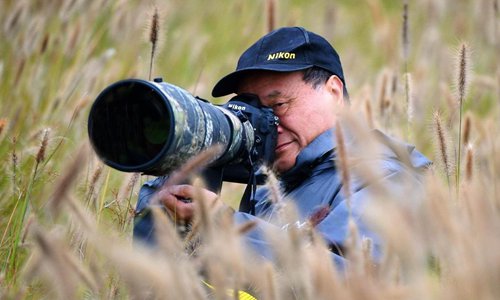
Yang Guomei's photographs of milu. (Photos/Courtesy of Yang Guomei)
If there is anyone who is an authority on Père David's deer, known in Chinese as milu, it has to be Yang Guomei.
As the former county head of Dafeng, East China's Jiangsu Province, he participated in the reintroduction to China of the near-extinct Père David's deer from Britain in the 1980s and the establishment of the Dafeng Milu Nature Reserve, home to the biggest milu population in China.
His passion for the animal didn't stop there. Often seen with his cameras slung over his shoulder, the 72-year-old county head-turned photographer has been taking pictures of milu deers in Dafeng for over 30 years. Through his lens, he has recorded the growth of China's milu deer population from 39 to over 3,200. His artful photographs of milu have also earned him China's top photography award and dozens of international awards.
Storied history
The milu is an animal native to China's central and lower Yangtze River basin. Through Chinese historical records, it can be traced to the 11th century BC during the Shang Dynasty (C.1600-1046BC), when legendary Chinese noble Jiang Ziya rode the creature to victory after overthrowing the tyrannical king of Shang and helped establish the Zhou Dynasty (1046-256BC). Milu then became symbols of good fortune and spiritual superiority.
For thousands of years, the creature was unknown to the Western world, until the late 19th Century when French missionary Armand David, also known as Père David, obtained the carcasses of several milu deer when he was in China. He sent them to Paris, where biologists named the deer after him. It was also at this time that a number of milu deer were illegally sent to Europe for exhibitions and breeding.
Meanwhile, milu gradually became extinct in their native country. By the late Qing Dynasty (1644-1911), the only milu herd in China lived in the Nanyuan Royal Hunting Garden in southern Beijing. During the invasion of the Eight-Nation Alliance in 1900, these last deer were captured and illegally sent to Europe, leading to the species' extinction in China.
For Yang, the extinction was a humiliating chapter in China's history. "It was a tragedy not just for the deer, but for our nation as well," Yang said.



















































